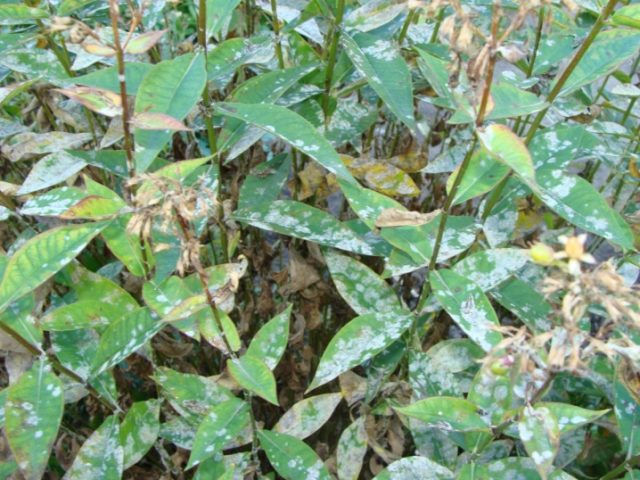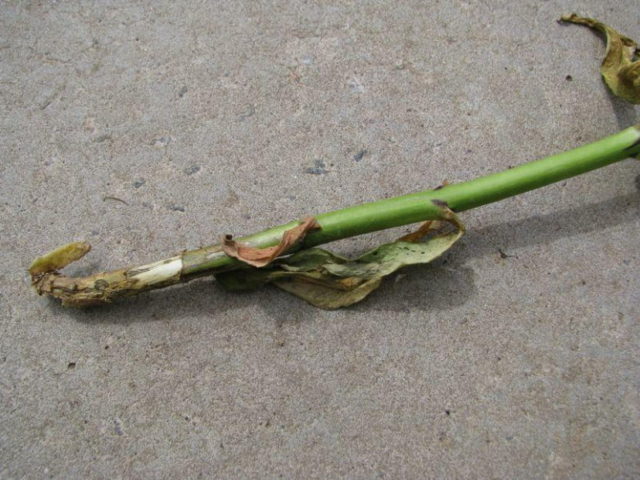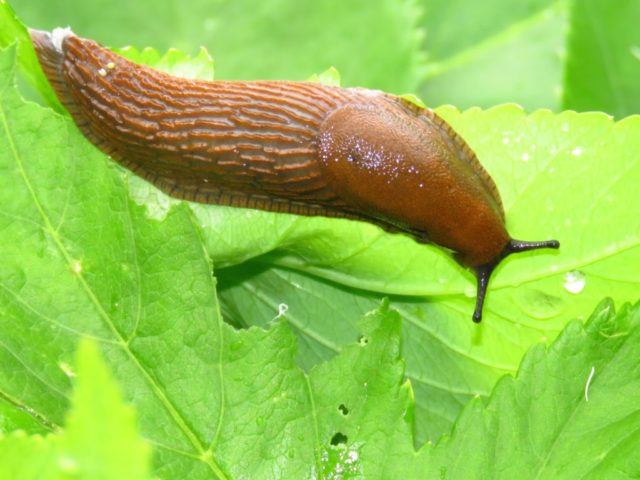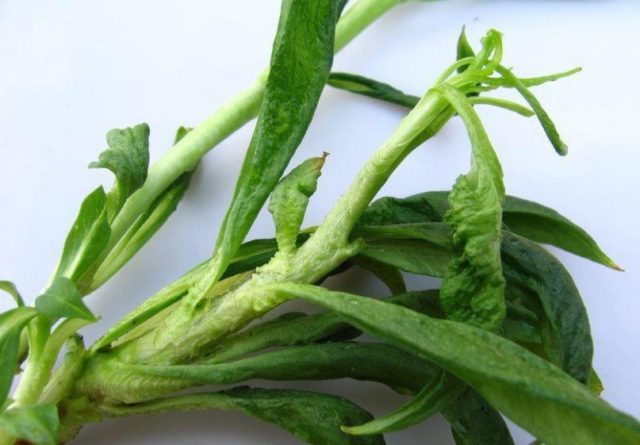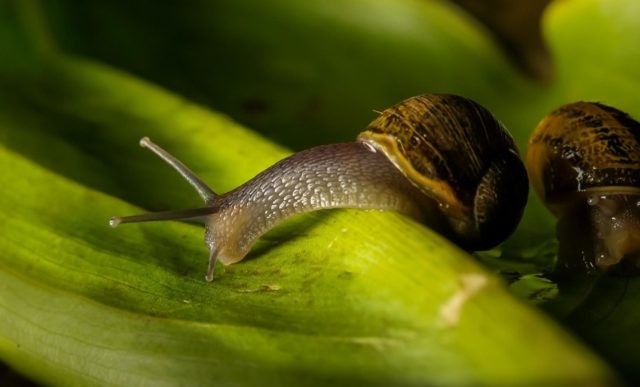Content
Split phlox is a perennial garden plant with interesting decorative qualities. Flowers are popular due to their beauty, but you need to take care of them according to all the rules.
Description of Perennial Spread Phlox
Wide-spread, Canadian or extended phlox is a perennial from the Sinyukhov family and the Phlox genus. The stems of the plant are dense, creeping type, the perennial forms a sod cover in the places of its growth. The leaves of the perennial are elongated, lanceolate, bright green. The plant blooms in May or June and forms inflorescences in the form of splayed scutes, hence the name. The drop-shaped phlox petals diverge to the sides, attaching to the core in tapering parts.

Perennial flowers resemble straightened shields
In height, the splayed phlox usually does not exceed 20-40 cm, the diameter of the bush is about 50-60 cm, and the diameter of the flowers is about 3 cm.The phlox is quite spreading in structure, several perennials planted nearby can form a bright noticeable flower bed.
The spreading Canadian phlox prefers to grow in partial shade or in illuminated areas with light shading after lunch. The plant needs soils moist and nutritious, slightly acidic, perennials can also grow on dry and poor soils, but not so actively. Under good conditions, the perennial adds several centimeters a year and forms a full-fledged flowering bush in about 3 seasons.
The homeland of the splayed phlox is North America, but currently it grows in Europe, in Russia in the middle lane and even in Siberia. The plant thrives best in the Central region with a mild climate, but it can grow in more severe areas in terms of climate. The frost resistance of the plant allows it to tolerate temperatures up to -30 ° C, and if you cover the perennial well, then lower temperatures will not lead to freezing.
Types and varieties of splayed phlox
The splayed phlox is available in many varieties. Among themselves, they differ in the height and color of the inflorescences - a wide variety allows gardeners to choose the most interesting plants for their site.
Chattahoochee
The wide-spread phlox variety usually does not exceed 25 cm in height, it produces raised inflorescences of a bluish-lilac color with a purple eye in the middle. The plant blooms in early spring, but with the onset of hot weather, flowering quickly stops. Due to its compactness and beauty, Chattahoochee's spread phlox is often grown in rock gardens and in pots.
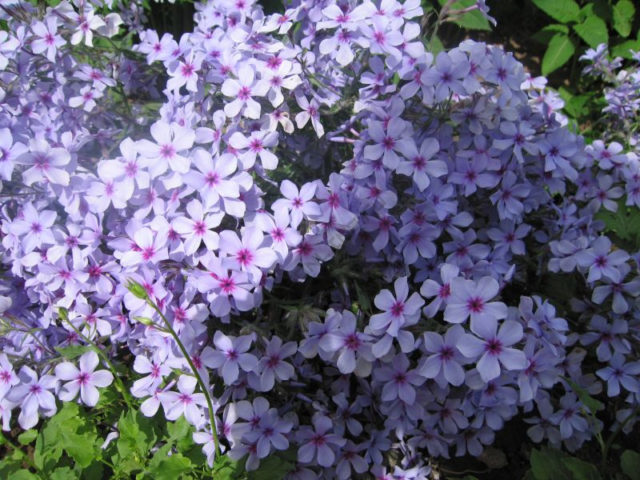
Chattahoochee is a compact variety with lilac blooms
White Perfume
Phlox spread out White Perfume gives dense and beautiful white flowers about 2 cm in diameter, sometimes several on one stem. Flowering occurs in May and June. The height of the plant is 30-40 cm, with the help of the splayed phlox White Perfume, you can form a beautiful carpet on the lawn in the garden.
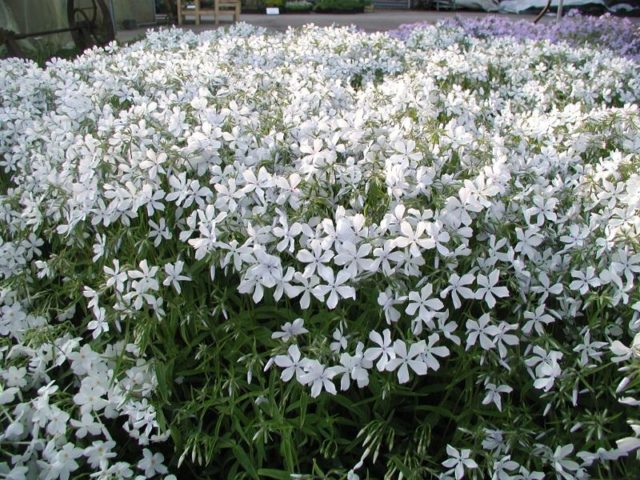
White Perfume - a variety with snow-white flowers
Blue Moon
The Blue Moon cultivar rises only 20 cm in height and produces very small flowers about 4 mm in diameter. They are blue-purple in shade.Mass flowering usually begins in late May and lasts until the last days of June, but if the splayed Blue Moon phlox grows in a shaded area, then the flowers can last longer. The variety, due to its short stature, is ideal for the formation of soil cover.
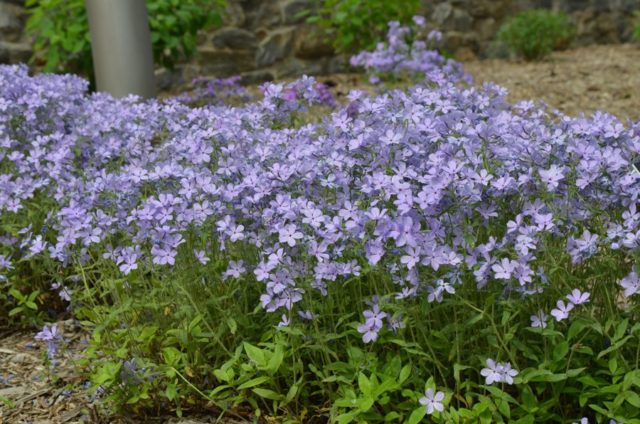
Blue Moon is a lavender blue variety with small flowers
Clouds of Perfume
The phlox height of this variety averages 25-30 cm. The plant produces beautiful lavender flowers in mid-spring and exudes a pleasant lavender aroma, this is the reason for the name. The spread-out blue phlox prefers to grow in partial shade, it can spread out 60 cm in width, forming a bright turf in the area occupied.
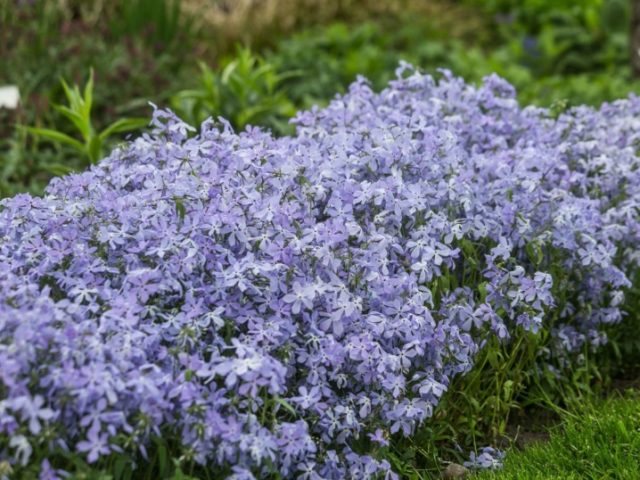
Clouds of Perfume - blue phlox variety
Variegata
Variegata is a very unusual variegated phlox. The leaf plates of the perennial are green, but with a white border around the edges, the flowers are pinkish-lilac, with a dark eye in the core. The height of the Variegata does not exceed 30 cm, blooms from late May to early July.
The plant prefers warm, well-lit areas, while reacting negatively to stagnant moisture in the soil. It is best to plant Variegata as part of alpine hills and curbs located in the sun.

Variegata is a variety with a two-color leaf color
Monstrose tricolor
Another unusual splayed phlox is distinguished by tricolor leaves - green leaf plates are decorated with white and pink stripes. An adult perennial rises 30 cm from the ground, blooms in May-June with lavender flowers. At the same time, in sunny areas, Montrose Tricolor brings more flowers, and in shaded areas, it continues to bloom longer.
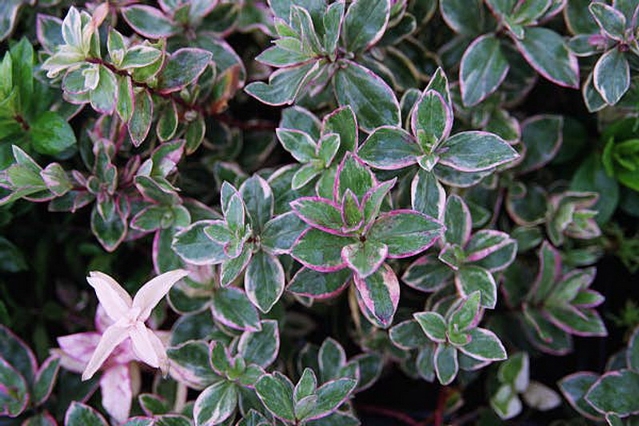
Montrose Tricolor - variety with tricolor leaves
Application in design
Spread phlox is widely used in landscape design; it can be included in flower beds and rock gardens, mixborders. With the help of a plant, they decorate garden paths or simply plant it in empty areas to form a beautiful floral carpet.
White splayed phlox is an excellent neighbor for conifers, as it looks very advantageous against a dark green background. Also, the perennial is planted next to badan and astrantia, variegated molin, with geraniums and asters.

With the help of a perennial, a very beautiful soil cover can be formed.
A popular option for forming a flower bed is planting several varieties of phlox in one composition. Contrary to the common misconception, it is possible to plant side by side, including varieties of different colors, this will not affect their health, beauty and color saturation in any way.
Because splay phlox is a very short and compact plant, it is often grown in pots and flowerpots. In this case, you can put a perennial on a balcony, loggia or on a terrace, it will revive the situation and does not require special care. The main thing is not to forget that you need to keep plants in pots in diffused light, protecting them from direct sunlight, otherwise the roots of perennials will overheat inside flowerpots and pots.
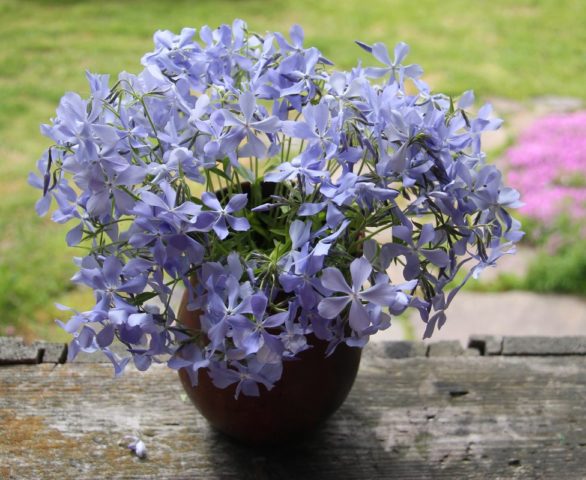
Perennial grows well in pots and flowerpots
Reproduction methods
You can propagate a spread-out phlox on a site in several ways:
- By dividing the bush. An adult perennial can be carefully dug out of the ground in spring or early autumn and divided into 2-3 parts for planting. In this case, you need to try not to damage the roots.
- By cuttings. In mid-May, a young, strong shoot with 2 internodes should be cut off from a phlox bush, planted in moist soil and covered with a glass jar on top. After a couple of months, phlox will take root, and the next season it will be able to bloom.
- Layers. This breeding method is one of the easiest, since the perennial stems almost creep along the ground. One of the shoots should be lightly sprinkled with soil and moistened during the warm season, the cuttings will quickly take root. It can be planted next spring.
- Seeds. The growing procedure looks simple. The seeds are slightly buried in the soil of peat, sand, humus and deciduous soil, and then covered with a film and regularly moistened the soil until sprouts appear. But in fact, plants reproduce by seeds rather poorly, and it takes a lot of time to germinate.
Most often, layering and dividing the bush are used for breeding phlox - these are the simplest and most effective methods. Cuttings and seed propagation are energy intensive.
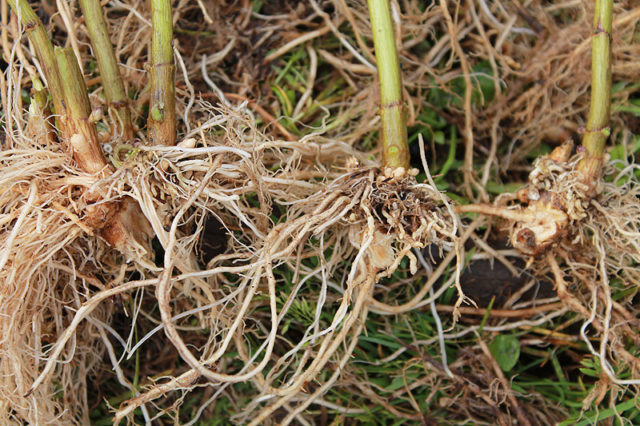
The perennial is propagated vegetatively - by layering, cuttings and dividing the bush
Planting and caring for a splayed phlox
It is recommended to plant spread-out phlox in the garden in the middle or late spring, when the ground is completely thawed and warmed up. However, it is important not to be late with the dates, if you start planting too late, then in hot weather the plant will develop more slowly.
Half-shaded areas of the garden or places where the shade sets in the afternoon are ideal for planting splay phlox. The perennial grows poorly in dense shade, but it does not feel very well in the bright sun either. The soil for the plant should be well moistened, but not waterlogged. Slightly acidified, fertile and loose soils are well suited in composition.
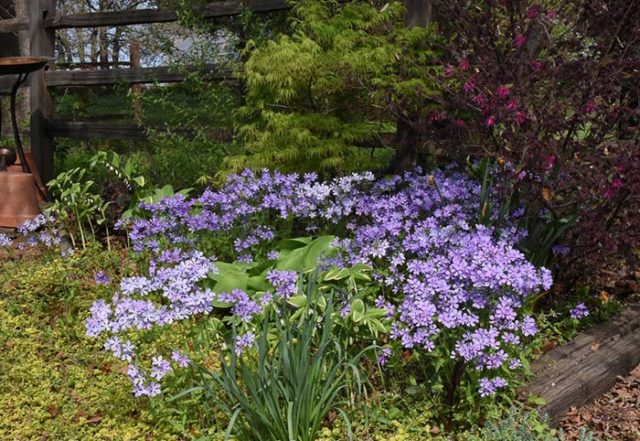
It is best to plant phlox next to a pond.
Before planting a splayed phlox, you must choose a quality material with a greenish stem at the base. A good cut should have 4 - 6 strong shoots with healthy buds and a few leaves. Delenka's roots should be about 15 cm long. Immediately before planting, phlox should be soaked in water for a couple of hours and its roots should be slightly cut.
The planting algorithm itself looks like this:
- The selected area is dug up and watered abundantly, then a small hole is dug about 30 cm deep and 50 cm wide.
- Complex fertilizers are poured at the bottom of the hole, and the top is half-filled with fertile soil mixed with sand and peat.
- A lot of spread-out phlox is dipped into the hole and the roots are sprinkled. In this case, the vegetative buds should remain about 5 cm above the ground.
Immediately after planting, the plant is watered and mulched with peat. If phloxes are planted in large quantities, then the distance between them should be left at 45-60 cm.

Perennial loves moisture, but reacts poorly to boggy
Follow-up care
Taking care of phlox is easy enough. When growing a perennial plant, it is important to pay attention to watering, they must be regular. In hot weather, it is necessary to moisten the splayed phlox daily, although little by little; on rainy days, 1 watering per week will be enough.
Fertilizing a plant has a positive effect on flowering, therefore phlox should be fertilized from late spring to mid-summer. Usually, chicken manure and superphosphate are introduced into the soil before flowering, and superphosphate, potassium salt and fluoride fertilizers are added directly during flowering. After flowering, the bushes can no longer be fed, until the end of the season they will have enough nutrients remaining in the soil.
In the fertile loose soil on which decorative flowers grow, weeds are often formed. They take away moisture and nutrients from perennials, and therefore require mandatory removal. Gently loosen the soil in the flower beds with the plant at least twice a month.
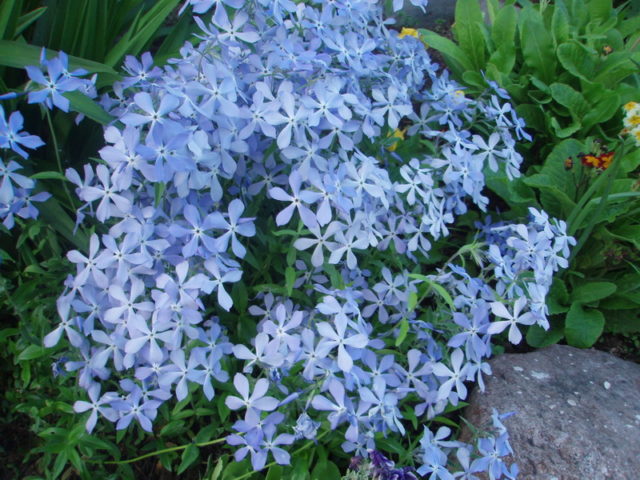
The plant is fed only before and during flowering
Preparing for winter
Phlox has good frost resistance, but requires special preparation for winter. With the onset of autumn, it is necessary to carry out several procedures:
- Pruning. At the end of flowering, the splayed phlox is cut off so as to remove all wilted inflorescences and leave only green shoots above the ground, rising by about 10 cm.To protect against pests and fungi, the base of the bushes is then sprayed with fungicides and insecticidal agents.
- Top dressing. In early or mid-October, the land under the bushes is abundantly mulched with organic fertilizers - half a bucket of horse manure or 3/4 of a bucket of peat. Organic matter will help insulate the perennial roots and at the same time nourish the plant with useful substances.
Before the onset of cold weather, the cut, spread-out phlox is thrown with tops or spruce branches. It is not customary to flock with lutrasil or burlap, there is enough light cover for the plant to calmly survive the frosts.
Pests and diseases
With careless care, the splayed phlox often suffers from several ailments:
- Powdery mildew - a "fluffy" coating of white appears on the leaves. Over time, the leaves begin to wither and the plant dies.
Powdery mildew shows up with a recognizable white bloom
- Septoria - the leaves are covered with grayish and brown dots and spots. The foliage turns yellow and dries, the phlox can completely die.
Septoria disease leads to premature wilting of leaves
- Fomoz - foliage curls at the bottom. The full nutrition of the perennial is disrupted, the plant begins to wither and dries up.
With phomosis, the disease spreads from the lower part of the perennial upward
- Rust - the leaves are covered with small but frequent brown dots. Soon the foliage dries up and falls off, the phlox's vital activity stops.
You can recognize rust by stains of a characteristic rusty color.
For fungal ailments, spraying with Bordeaux liquid and copper sulfate helps well, you can also use Fundazol.
Of the pests for perennials are dangerous:
- slugs - pests feed on vital foliage juices;
The easiest way to spot slugs on a splayed phlox is
- spider mite - with a serious infection, a whitish cobweb can be seen on the leaves;
Spider mite infestation is characterized by brown spots and spider webs on foliage
- nematodes - microscopic worms lead to thickening of the stems and thinning of the upper shoots;
It is difficult to spot nematode worms, usually symptoms appear in the late stages of infection
- snails - small molluscs harm perennials, as they feed on foliage juices.
Outwardly harmless snails can destroy a decorative flower bed
To cure insect infestation, Kinmix and Aktar products allow, and in order to notice pests in time, it is worth regularly examining the leaves and stems of the plant.
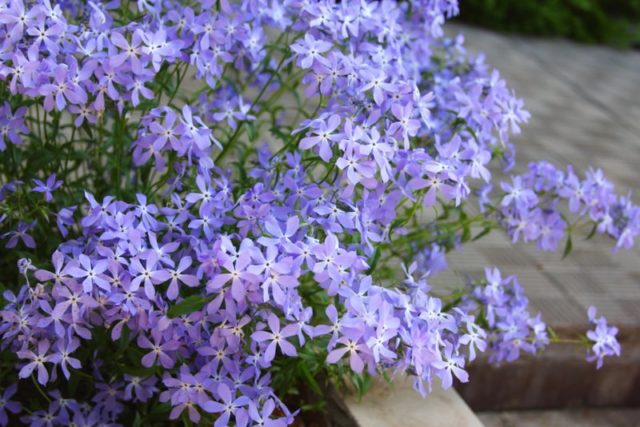
You can even grow a blooming perennial on the balcony.
Conclusion
Split phlox is a beautiful undersized perennial with long flowering. In the garden, the plant is used to create flower beds, rock gardens and to decorate lawns and slopes, while caring for a perennial is quite simple.
